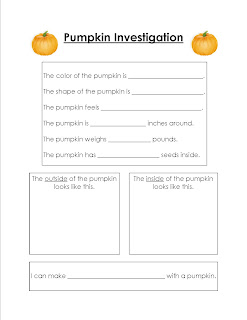Number of the Week: 10
Bible Verse of the Week: "Every good and perfect gift is from above." James 1:17
Books:
Songs:
* Great songs here from Suite 101.
_____________________________________
Lesson 1: Pumpkin Patch Field Trip
Objectives:
* To visit a pumpkin patch
* To learn what pumpkins are and their characteristics
* To recognize the differences in pumpkins (different sizes and shapes)
* To pick out/purchase a pumpkin
Materials:
* camera :)
* money to buy a pumpkin
Procedure:
1. Visit your local pumpkin patch! Talk about pumpkins and walk around to discover how each one is different. Have your child pick out one to use during the week's lessons. And, of course, take lots of pictures!
 |
| Sweet Brothers |
 |
| Checking out the pumpkins! |
 |
| Getting so big! |
 |
| Going for the big one! |
 |
| Of course, Tucker wanted to eat it! |
 |
| Being Silly! |
Lesson 2: Pumpkin Investigation
Objectives:
* To understand the characteristics of a pumpkin
* To find out information on your specific pumpkin including measurements, number of seeds inside, etc.
* To use measuring, counting, and observation skills
* To use the fine motor skills involved with cutting and writing
Materials:
* Pumpkin Investigation Printable
* plate
* knives (one real and one plastic)
* measuring tape
* scale
* pencil or crayon
Procedure:
1. Have your child pick up the pumpkin and observe it. Ask them to use their senses and describe it. Fill in the blanks on the investigation worksheet.
2. Measure the pumpkin and write the number on the worksheet. Then weigh it on the scale and write this information, as well.
3. Time to get messy! Cut a hole in the top of the pumpkin, and have your child dig in! Let them describe the inside of the pumpkin and how it is different from the outside. Remember to have them draw pictures of each.
4. Have your child pull out the seeds and place them on the plate. You will probably have to help them clean out the whole pumpkin. Your child might not be able to count all of the seeds inside since there are so many, but have them tell you if there are a lot of seeds or just a few.
5. Talk about the many things we bake with pumpkins. (pies, cookies, soups, etc.) Then discuss how you can create jack-o-lanterns, as well. Ask your child to choose specific shapes for the face of the jack-o-lantern that you make. Let them make little cuts with their plastic knife.
Lesson 3: Pumpkin Growth Sequence - From Seed to Pumpkin Book
Objectives:
* To understand the sequence of the life cycle of a pumpkin and be able to put pictures of the cycle in the correct order
* To state the life cycle of a pumpkin
* To create a life cycle book using the fine motor skills involved with cutting, hole punching, and tying
Materials:
* life cycle printables from Montessori For Everyone
* 2 pumpkin printouts (I just used clipart)
* scissors
* hole punch
* ribbon or ring to hold book together
* book about pumpkin life cycle if you have one
Procedure:
1. Read or tell your child about the life cycle of a pumpkin. Talk about the sequence of the cycle and the specific order that a pumpkin grows in. Cut out the pictures of the life cycle and have your child place them in the correct order.2. On one of the pumpkins, write "From Seed to Pumpkin" as the title of your little book.
3. Align the pictures with the pumpkins and punch a hole in the top and tie a ribbon to create the book.
4. Review this cycle with your book throughout the week!
Lesson 4: Pumpkin Craft
Objectives:
* To review the characteristics of pumpkins, focusing on the outside
* To create a pumpkin craft using the fine motor skills involved with tearing and gluing
Materials:
* pumpkin printable (you can use any pumpkin printout you want to)
* orange, green, and brown construction paper
* glue
Procedure:
1. Tear the orange construction paper into small pieces and glue them on the pumpkin shape. This is a great activity to build up the tiny muscles in your child's hands and fingers.
1. Tear the orange construction paper into small pieces and glue them on the pumpkin shape. This is a great activity to build up the tiny muscles in your child's hands and fingers.
2. Tear a few small pieces of brown construction paper and glue them on the stem of the pumpkin. Discuss how the stem connects the pumpkin to the vine that it grows on.
3. Tear some green pieces of paper and glue them around the stem for leaves.
Lesson 5: Pumpkin Cooking
Objectives:
1. To recognize that pumpkin can be cooked in many different ways and in many different dishes
* To cook whatever you'd like with pumpkin
* To use measurement and cooking skills
* To follow a recipe and understand the order of steps in cooking
* To use the motor skills involved with pouring, stirring, etc.
Materials:
(This lesson is up to you! There are so many recipes out there with pumpkin, and I'm sure you have your favorites! Cook whatever your craving!)
* whatever your recipe calls for
Procedure:
* Follow your recipe! Here are a few that I like:
1. Pumpkin Cheesecake
2. Pumpkin Cookies
3. Pumpkin Gingerbread
Extra Thinking
* Letter Pp - cute crafts here from Totally Tots
* Pumpkin Lessons from 2 Teaching Mommies
* Compare pumpkins and apples in order to review their characteristics and learn their similarities and differences. You can use a venn diagram for this.
































No comments:
Post a Comment